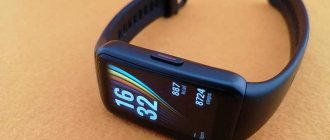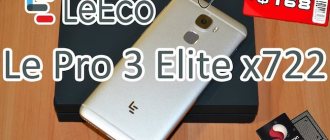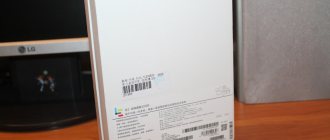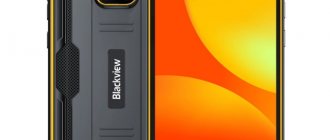LeTV LeEco Le S3 X626 is an original smartphone that, although not new (not supported by the manufacturer), has very good characteristics for its price, even at the end of 2022. The new LeTV Le S3 X626 on the Chinese Internet site CooliCool now costs about $95 (6,000 rubles).
LeEco is a very popular brand in the Asian market and one of the three most recognizable. In a short period of time, the company managed to fill most segments of the smartphone market with its products. It’s also worth emphasizing here that the company’s offerings are not limited only to mobile phones.
The LeEco Le S3 X626 model, which came to me for review, is a device from the middle (cheaper) price shelf. I already had phones from this company, and, as it turned out, they were very good. Therefore, I do not hide that I had high hopes for the LeTV Le S3 X626, and I was sure it would be great. Is it so? Find out in the review.
Characteristics of LeEco Le S3 X626
| CPU | Helio X20 (MTK6797) 2.3 GHz, Deca Core |
| Screen | 5.5-inch 1920?1080; 403ppi |
| RAM | 4 GB |
| ROM | 32 GB |
| Cameras | 21-MP (main) and 8-MP (front) |
| Flash | Yes |
| Autofocus | Yes |
| Continuous photo | Yes |
| Shooting video | Yes |
| operating system | Android 6.0 |
| Battery | 3000 mAh |
| 3.5 mm jack | No (USB-C to 3.5mm adapter) |
| Memory card support | No |
| WIFI | Yes |
| GPS | Yes, built-in |
| Bluetooth | Bluetooth 4.2 |
| Network frequencies | WCDMA 850/900/1900/2100 MHz, FDD-LTE B1/B3/B7, GSM 850/900/1800/1900 MHz |
| Gravity | Yes |
| Distances | Yes |
| Sveta | Yes |
| NFC | No |
| OTG | Yes |
| Connector | USB Type-C |
| Audio formats | MP3/ACC/AAC+/WAV/AMR |
| Video formats | MP4/3GP/MPEG-4 |
| Language support | English, German, Spanish, Italian, French, Portuguese, Russian, Thai, Arabic, Turkish, Vietnamese, Malay, Chinese (Simplified), Chinese (Traditional), etc. |
Results
pros
- Its up-to-date hardware copes well with everyday tasks and some heavy-duty games.
- The device runs its own proprietary OS.
- Price.
- Sealed Type C port.
Minuses
- The black frames around the display do not look modern.
- Battery capacity.
- Lack of 3.5 mm audio output.
- There is no need to wait for firmware updates.
The result is an average phone with its pros and cons. Is it worth taking it? Could it become a competitor to smartphones from Xiaomi and Meizu? Most likely not, especially for the Russian segment.
Design and appearance
LeTV LeEco Le S3 is very similar to the company's previous smartphones. The quality of materials, design and screen are almost identical to other LeTVs and are at a high level. The metal alloy back gives a premium feel, while the two stripes at the bottom and top add variety to the monolithic design.
On the back panel, the eye is immediately focused on the protruding camera, which, although it fits well with the entire structure of the LeEco Le S3 X626, is a little impractical, since we can scratch the glass protecting the camera. On the left side there is a slot for SIM cards, on the right there is a power and volume button.
On the bottom edge there is a USB-C port and speaker grilles, one of which is for symmetry. Unfortunately, the smartphone does not support memory cards, so before purchasing it is better to think about which version to choose. You won't find a headphone jack on the top of the Le S3 X626, but the included USB adapter should compensate for this. On the top edge there is an IRDA port (infrared port), which can be used, for example, to control a TV or other devices that support this communication mode.
Here it is also worth paying attention to the beautifully designed frames on both sides of the LeTV Le S3 X626. The smartphone is made of very good materials, almost all elements are metal. To summarize, the design is a definite advantage of this model, although it requires protection in the form of a case.
Smartphone display
The LeEco Le S3 screen is of very good quality, despite the price of the gadget, all colors look good and correct. LeTV Le S3 X626 has a 5.5-inch display with a resolution of 1080p (FHD), protected by Corning Gorilla Glass 3. You can always change the color temperature in the settings of your smartphone. But in my opinion, it is better to leave everything as default.
The viewing angles of the LeTV LeEco Le S3 X626 are large, but not surprising. The brightness here is also flawless. Everything is easy to read on a sunny day, and the minimum brightness allows you to comfortably use the phone in the dark.
Additional functions
The LeEco LeTV Le 3S (X626) smartphone has a number of additional functions:
- An infrared port makes it possible to control some household appliances
- Light sensor automatically sets the brightness level for the display
- Proximity sensor automatically turns off the screen when you bring the device to your ear to prevent unplanned operations
- The gravity sensor (G-sensor), accelerometer, and gyroscope are responsible for rotating the display in different planes
- The Hall sensor is located between the main and left virtual buttons
- Digital compass
- Pedometer
Performance
Le S3 X626 is equipped with a 10-core Helio X20 (MT6797) processor clocked at 2.3 GHz, supported by 3/4 GB of RAM and 32/64 GB of internal memory (depending on version). The LeTV LeEco Le S3 I tested has 4/32 GB. The processor is paired with an Arm Mali-T880 (780 MHz) graphics chip.
The device received 97,490 points in the AnTuTu test. The LeEco Le S3 X626 phone is fast and I did not notice any lags during a month of use, it is 100% sufficient for average users. However, when you open multiple applications at the same time, the device slows down noticeably.
Information about the hardware. Performance. Tests.
The smartphone uses a MediaTek Helio X20 (MT6797) 20nm processor, 10 processor cores, which are divided into three clusters.
The first includes two Cortex-A72 cores operating at a maximum frequency of 2.5 GHz. The second cluster has four Cortex-A53 cores operating at frequencies up to 2 GHz. The third cluster is the same four Cortex-A53 cores, but their operating frequency is reduced to 1.4 GHz. This processor is not at all new, but it’s quite a good processor, and given the price, it’s not at all right to find fault with it. The smartphone scored 97 thousand points in Antutu
CPU-Z
3D Mark, PC Mark
Device info
Geekbench 4
Epic Citadel
When running Antutu, the number of points could decrease by 1000-2000, which is not critical. But Epic Citadel in ultra settings, heating is more sensitive and the performance can drop to 38-40 fps.
Memory test
Good set of sensors
I checked the operation of the smartphone in games, first installed Asphalt 8, at maximum settings everything works well
In world of tank, the graphics settings are in high quality. The fps meter shows 45-50 frames, sometimes briefly dropping to 30.
Navigation system
The phone supports GPS, Glonass, beidou satellites. Navigation works well, connects to satellites quickly. I recorded the track, everything was recorded exactly as I was driving, excellent results. No comments. On the third screen you can even see how he changed lanes from the fourth to the first lane.
Interface and system
LeTV Le S3 runs on Android 6.0 Marshmallow OS with EUI (Ecosystem User Interface) user interface. The system is not new and I could not find information about updating it to a more recent Android. Unfortunately, the manufacturer also has no visible support for its devices (no updates, no patches), which is a bad approach towards customers.
The LeTV LeEco Le S3 X626 smartphone has a clear and grouped menu interface, but you may notice its shortcomings, especially if you delve deeper into the settings. After several reboots, my device worked stably, and I must admit, not bad. The charm here is ruined by the inability to change the system, but if one is not a demanding user, then he will certainly be satisfied.
The OS reproduces everything as it should and this does not have a significant impact on the comfort during operation. There are quite a few patched versions of the software, some of which will require you to root to download third-party software. For the average user this will probably be the main drawback (although it is possible).
Assessing device capabilities
Now let's turn to the most important part of the review, assessing the capabilities of the smartphone and the ease of working with it!
To begin with, I’ll note that those who are interested can watch my video review of this smartphone just below, which talks more about the characteristics of the device as a whole. But this is not a reason not to read further, because here I focus on information of a slightly different kind :) As you understand, in terms of the performance of the device in this review, I won’t overclock it too much, I’ll just say that for my tasks the capabilities of this smartphone are enough for the eyes . So that you understand, my tasks are consuming media content and playing games that are not demanding on the device’s resources. But he also attracts the demanding ones with a bang! Tested on the same video at the end of the article. At the same time, however, the smartphone heats up noticeably.
On the positive side, I would also note the device’s good multitasking capabilities; about 7-8 applications can easily hang in the background until you access them; a cool screen with fairly rich colors, an excellent brightness adjustment range, good viewing angles and a high-quality oleophobic coating; very loud main speaker.
What I definitely don't like is the lack of a standard headphone jack. For me personally, this sometimes creates problems. If I have still come to terms with the need to use an adapter (especially since its presence is even a plus, since it is it that will fail, and not the headset itself), then the impossibility of simultaneously connecting headphones and charging is sometimes downright infuriating. Again, the problem can be solved: either we use Bluetooth headphones, or we buy an adapter for a Jack connector with an additional input for charging for $2-3. But, guys, isn’t there too much body movement to do?!
While the bluetooth is flying towards me, the fast charging function helps out, which, as you already understand, is implemented in this smartphone. In just half an hour of power from the network you already have 50% charge, after 1 hour 30 minutes - 100%. This is really cool and very important considering the fact that the autonomy of the Le S3, in my subjective opinion, leaves much to be desired. In everyday affairs, it is quite capable of surviving a day, but only if you do not decide to spend 5-6 hours continuously on the smartphone screen.
Firmware
In the case of Leeco Le S3, there is no talk of any globalization at the official level, there is only a translation from Chinese to English and that’s it. For this reason, the seller installed custom firmware, which is 90% Russified and, in addition, devoid of several annoying features implemented in the official firmware. It works, in my opinion, very well and stably, but is quite outdated. Judge for yourself, we are dealing with firmware version 20S, while the 26th version has been available on the network for a long time. Updating over the air is not possible, only manually, so you should think about whether you need it or not, especially since most of the updates that arrive, even if they solve a problem, always generate another. And so in 90% of cases. Our smartphone already works stably out of the box, so I won’t update anything. Although there are some nuances that are either not at all pleasing or a little annoying.
In fact, there are only two of them. The first one (the one that doesn’t make me happy at all) is that when working on the Internet via a mobile network, the battery charge melts before our eyes. This is an obvious flaw of the smartphone software developers, the consequences of which may have been eliminated by subsequent updates. The second nuance is how autofocus works when shooting video. Believe it or not, it only works after turning the flash on/off. That is, initially one gets the feeling that it is not there at all, although in fact it is there, you just need to do this simple manipulation. This is weird! What prevented you from bringing the matter to fruition? Or maybe it shouldn’t have worked when filming and such a mistake is only a plus for us?) Who knows...
Walking through the EUI shell
The branded shell is very non-standard and requires special attention. Let me start with the fact that the functionality of the notification curtain has been radically rethought here. In fact, it is now only intended to display notifications from smartphone applications. You can select the applications from which you want to receive notifications.
There are no usual settings here; they are all moved to the menu of running applications. At first, this looks inconvenient; developers need to get used to this decision. However, a couple of days, and you will already be well versed in the mysterious inner world of the Leeco Le S3. For your convenience, below I will present several screenshots with some explanations.
Menu of running applications
I would like to pay special attention to a separate shortcut on the smartphone’s desktop called “Phone Manager”. Or rather, the functionality hiding behind it. Click on the icon...
We are presented with such a list of possibilities, the first item in which is “Garbage Removal”. That is, you don’t need to install all sorts of junk with a bunch of ads like “Clean Master”.
The next item is “Data transfer monitoring”. Here, in principle, everything is clear: we look at how many MB were burned on the Internet, set limits, etc.
We go further and see the “Energy Saving Management” tab. Among its functionality, we note the ability to enable extreme battery saving mode, configure the device to turn on/off at a given time, and monitor energy consumption by applications.
Below in the list is the item “Security and Privacy”. And the first thing that immediately catches our eye is the “Virus Detection” tab. Yes, yes, the firmware has a built-in antivirus with virus detection technologies borrowed from Tencent and AntiVirus. Updates arrive over the air even though it is impossible to update the firmware of the entire device in this way.
The next two subparagraphs imply setting up the protection of applications and confidential data using a password, pattern, etc. This is important, especially if you don’t want anyone with access to a smartphone to climb where they’re not supposed to.
Well, the last settings in this tab are managing the startup of applications and their permissions. I think there is no need for additional explanations here.
Perhaps we’ll stop here and turn our attention to some other nuances. For example, the fact that Dolby Atmos is built into the firmware, which software improves the sound on the entire smartphone. I must say that it has not been fully developed by the developers here (you won’t configure anything yourself), but in general it works, really making adjustments to the sound of the smartphone.
Cameras LeTV LeEco Le S3 X626
It's time for optics that, while not top-of-the-line considering the price, can still take interesting pictures. The main camera of the LeEco Le S3 X626 has problems with proper focusing, but this is its biggest disadvantage. I expected more from a 16-megapixel camera with Omnivision OV1688 (f/2.0), however, I don’t know which smartphone with a price of $100 takes the best photos.
Daytime photos come out of very good quality. The Le S3 X626's camera is slightly better than most Chinese smartphones, at least at this price. During the day it does a decent job, and I even wanted to write that this is a very good camera. However, when the sun drops below the horizon, it takes a steady hand and good adjustments so that the image can be processed later. This applies to most mid-size smartphones, and not just Chinese ones.
In LeTV LeEco Le S3 you can use the HDR mode, but you must take into account that then shooting takes much longer. The basis here is stability. On the front of the LeTV Le S3 X626 there is a lens with an f/2.2 aperture. Don't expect much from this lens, within reason you can take good selfies.
I've read several reviews online about the Le S3 optics and have received varying opinions. The LeTV LeEco Le S3 X626 cameras were most often described as an advantage rather than a disadvantage. Whether this is due to the fact that the selected model was tested by people who rated the main camera as good and never tested other optics or not, I don’t know. The truth is that you can get beautiful photos here, but it will require a little fiddling with the settings.
Camera
The gadget has two cameras:
- The main one is 21 megapixel Sony IMX230 and f/2.0 aperture.
- Front 8 MP.
Phase detection autofocus is installed here, which has a low operating speed. He is often wrong. To activate autofocus directly during shooting, you need to turn it on and off (move the LED flash).
There is a nice feature that allows
take pictures using your fingerprint.
The sensor allows you to record 4K video in HDR mode. The sensor is capable of shooting in full resolution at 30 frames per second, making continuous shooting possible. When shooting 4K video, the frame rate also reaches 30 frames per second. The sensor supports high dynamic range (HDR) interlaced shooting technology and phase detection autofocus.
There is support for slow motion at 720p. There is no stabilizer here either in software or natural optical hardware. It will only appear if you install AOSP Kangburra v254.
Generally speaking, the color rendition of the photograph is not very good, especially in cloudy conditions or darkness.
Communications and connections
GPS in the LeTV LeEco Le S3 X626 phone is a mystery to me, from time to time I like to go outside and run, I take my phone with me when I run. And, to be honest, I was surprised to see the GPS results from my smartphone. One day its accuracy is up to standard, the next the signal is lost on the same route or the LeEco Le S3 X626 simply cannot find a signal (supported by A-GPS, Beidou, GLONASS, GPS). I suspect that this is due to the many buildings among which I am looking for a signal.
During testing, there were no problems with the quality of car navigation, but if you want more accurate results (for example, when riding a bicycle), you may be disappointed. Also, for some, the lack of LTE B20 will be a disadvantage. Networks supported:
- 2G GSM 1800 MHz, 1900 MHz and GSM 850 MHz, GSM 900 MHz.
- 3G: WCDMA 2100 MHz B1, WCDMA 1900 MHz B2, WCDMA B5 850 MG, 900 MG WCDMA B8.
- TD-SCDMA TD-SCDMA В34/В39.
- 4G LTE: FDD B1 2100 MHz, FDD B3 1800 MHz, FDD B7 2600 MHz, TDD B38 2600 MHz, TDD B39 1900 MHz, TDD B40 2300 MHz, TDD B41 2500 MHz.
- WIFI: 802.11a/b/g/n/ac wireless internet.
Autonomy LeEco Le S3 X626
The energy optimization on the LeTV Le S3 smartphone is quite good. The 3000 mAh battery does not make much of an impression; it is a standard capacity for most devices in this class. With my operating mode I have two days of battery life. However, if I started surfing the Internet more and launching several games during the day, it all came down to one day of autonomy.
In economy mode (calls, SMS, and sometimes internet) I could even get 3 days on a single battery charge. However, few people today use the phone in this way.
Autonomy
The smartphone is powered by a 3000 mAh non-removable lithium-polymer battery. The low capacity is explained by the fact that the LeEco Le S3 is very thin, 7.5 mm. At 50% screen brightness, you can watch videos for 7 hours. The best option would be to charge your smartphone once a day. If you do not use it very actively, the charge lasts for 2 days.
The phone supports Qualcomm QC 3.0 fast charging technology. The charger operates in modes 3.6-8V at 3A, or 12 V at 2A. Modes are changed using a switch. Quick setup mode is activated in settings. It takes an hour and a half to charge normally. The last 10% of charge takes the longest to charge. Therefore, in half an hour the smartphone is charged by 40%. In fast charging mode, this happens faster, but the phone heats up while charging.
You can charge Leeco, model Le S3 (X626), for 20 minutes several times a day in fast charging mode or charge it overnight in normal mode. The smartphone works until the charge level is 0%. There are no sudden jumps or dips in battery performance. Overnight, the phone loses from 2 to 4% of its charge. The capacity of the Leree Le 3 model is significantly higher, 4060 mAh. A full charge is enough to work for 2 days.











